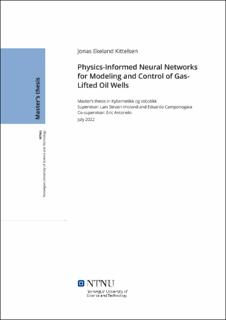| dc.contributor.advisor | Imsland, Lars Struen | |
| dc.contributor.advisor | Camponogara, Eduardo | |
| dc.contributor.advisor | Antonelo, Eric | |
| dc.contributor.author | Kittelsen, Jonas Ekeland | |
| dc.date.accessioned | 2022-11-29T18:19:28Z | |
| dc.date.available | 2022-11-29T18:19:28Z | |
| dc.date.issued | 2022 | |
| dc.identifier | no.ntnu:inspera:102231297:57773350 | |
| dc.identifier.uri | https://hdl.handle.net/11250/3034864 | |
| dc.description.abstract | Physics-Informed Neural Networks (PINNs) er en metode for å trene et nevral nettverk til å gjenskape oppførselen til et dynamisk system uten å ha tilgang til simulerte eller målte data, kun ved å bruke den kjente underliggende fysikken til systemet. Her vil et slikt nett bli trent til å reprodusere dynamikken til en gassløftet oljebrønn, kun ved bruk av systemets differensialligning. Det resulterende nevral nettet er i stand til å predikere systemets respons med god nøyaktighet 60 sekunder frem i tid, gitt den nåværende tilstanden til systemet og den nåværende posisjonen på produksjons ventilen (choken) og gassløft ventilen. Det er også mulig å predikere systemets tilstand lengre frem i tid ved å bruke dette nevral nettet flere ganger i en loop, for hver iterasjons vil vi predikere nye 60 sekunder frem i tid. Dette gjør nevral nettet anvendelig for Model Predictive Control (MPC). Resultatene i denne rapporten viser flere vellykkede MPC eksperimenter som kontrollerer både tilstandene i brønn modellen og trykket i bunnen av brønnen (bottom-hole). | |
| dc.description.abstract | Physics-Informed Neural Networks (PINNs) is a method of training a neural network to replicate the behavior of a dynamic system without having access to simulated or measured data, only utilizing the known underlying physical model of the system. Here, this method will be applied to a model of an unstable gas-lifted oil well, utilizing only the known differential equation during training of the PINN. The resulting neural network is able to predict the system's response 60 seconds ahead in time with good accuracy, given the current state measurements and the currently applied control input of the production choke and gas-lift valve. It is also able to predict the system's states further ahead by utilizing the same neural network in a loop, at each iteration progressing 60 seconds ahead in time. This makes the neural network applicable to Model Predictive Control (MPC). The results of this report show several successful MPC experiments controlling both the well states and the bottom-hole pressure of the oil well. | |
| dc.language | eng | |
| dc.publisher | NTNU | |
| dc.title | Physics-Informed Neural Networks for Modeling and Control of Gas-Lifted Oil Wells | |
| dc.type | Master thesis | |
